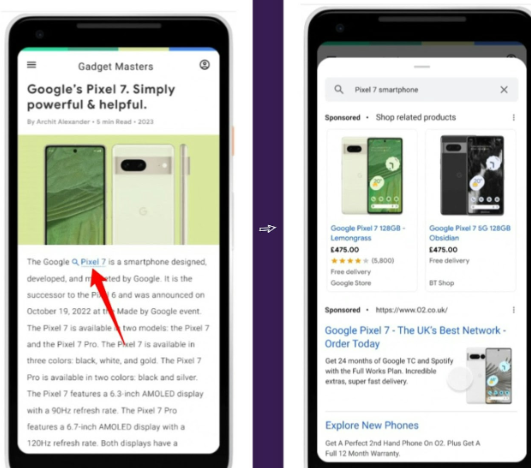This announcement is exciting for several reasons. It will incentivize content creators to continually create new, fresh, and helpful content for their audience.
Ad intents are part of Auto Ads. (They have Nothing to do with automobiles—the ads are automatic.) Here is Google’s announcement on Auto Ads from 2018. It’s a system that uses machine learning to make intelligent decisions on where to place ads. You put a line of code on your site, and then Google does the rest.
Some site owners like this program, but I’ve spoken with a few unhappy with the ad experience auto ads produce for their readers. The Ad Intents program will produce much better ads.
If you install Auto ads, the new Ad intents will use an intent-driven format that places links in your existing text.

There’s also an option to show an “Ad intent anchor”—the image shows a popup that appears at the bottom of the content.
People will click on these ads because they are helpful. They could generate new revenue for bloggers and incentivize us to create new, fresh, and useful content continually.
These ads are intent-based. Google is getting better and better at figuring out what the searcher wants or will find helpful. The Auto Ad system uses machine learning to determine where an ad will most likely make you money. Google says it “shows highly relevant ads that don’t rely on third-party cookies.”
This new type of ad will only work for some sites. Some people have said that the current system (before ad intent links were added) can add ugly-looking ads or even slow the site down. But if you currently use an ad network to generate revenue from your content views, this new option will be worth investigating.
Say you’re a gardener with a blog who has cultivated a following via social media and YouTube. You may have a famous recipe blog. How do you make money with your blog? You need to create and sell a product, run ads, or do what most bloggers do: use links to affiliate programs. If someone clicks on one of your recommendations and buys a product, you can get an affiliate commission.
With what I’m picturing with auto ads, this blogger could write a new post and talk about what they’re doing and learning, and then Ad Intents will do its work by “scanning your pages for opportunities to help your users find something they might be looking for.“
Instead of:
I used this new Weed-o-matic tool to weed my garden. Here’s a link to buy it on Amazon or a few other sellers (that have affiliate programs).
Now, if Google’s systems determine that readers may want to buy this product:
I used this Weed-o-matic to weed my garden.
The creator is freed up to create rather than sell!
That link would open a search, including new ads, where people can decide on buying a Weed-o-matic. The blogger gets paid for ad clicks (and maybe impressions? I’m not sure) rather than affiliate sales. And really, there should be a lot of ad clicks because the system is built around understanding intent and where there is potential to maximize revenue.
I can’t stop thinking about this program.
There is much opportunity here if you are creating content for an audience hungry for it. Barry Schwartz has written more here on ad intents worth reading. Only some people are happy about this change. Who wants more ads? Google Ads Liaison says it is opt-in and entirely optional. Adshyper personalized ads will be a good thing for the web.
Also, these ads are cookie-less. In October, Google told us to prepare for the end of third-party cookies. A lot is changing!